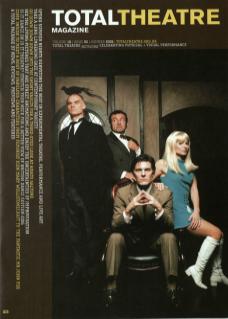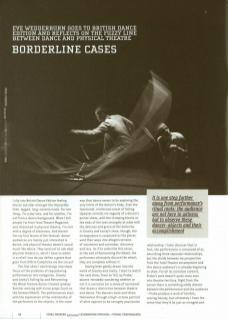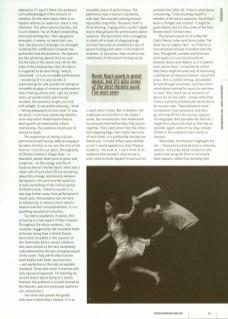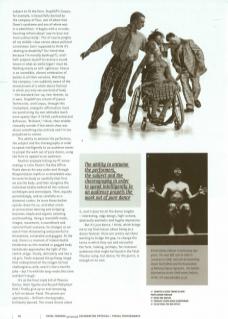I slip into British Dance Edition feeling like an outsider amongst the impossibly lithe-legged, long-necked crowd. For one thing, I'm a day late, and for another, I'm not from a dance background. When I tell people I'm from Total Theatre Magazine, and interested in physical theatre, I'm met with a degree of blankness. And therein lies my first lesson of the festival: dance audiences are mainly just interested in dance, and physical theatre doesn't sound much like dance. They tend not to ask what physical theatre is, which I have to admit is a relief: how do you define a genre that goes from DV8 to Complicite via the circus?
The first show I catch brings into sharp focus all the problems of sequestering performances into categories. Gravity and Levity's Falling Up and Reinventing the Wheel feature dance-trained Lyndsey Butcher working with circus props (such as the German Wheel). The performances start with the exploration of the relationship of the performers to the objects, in the same way that dance seems to be exploring the very limits of the dancer's body. Even the functional, reinforced corset of Falling Upwards reminds me vaguely of a dancer's pointe shoes, with the clumping blocks at the ends of the toes strangely at odds with the delicacy and grace of the ballerina. In Gravity and Levity's show, though, the incongruence is surpassed as the pieces wind their ways into allegorical tales of resistance and surrender, discovery and loss. As if to underline this sense, at the end of Reinventing the Wheel the performers ultimately discard the wheel; they are complete without it.
Having been gently drawn into the world of Gravity and Levity, I start to watch the next show, Fever to Tell, by Probe, absent-mindedly wondering whether or not it is narrative (or a sense of narrative) that draws a distinction between theatre and dance. The dancers twist and throw themselves through a high-octane portrait of what appears to be a savagely passionate relationship. I later discover that, in fact, the performance is conceived of as describing three separate relationships, but the divide between my perspective from the Total Theatre encampment and this dance audience's is already beginning to show. For all its narrative content, Probe's work doesn't quite cross over into theatre territory. Right from the outset there is something oddly distant between the performance and the audience – Probe produce a work of terrible, searing beauty, but ultimately I have the sense that they'd be just as enraged and expressive if I wasn't there; the audience isn't acknowledged in the moment of creation. On the other hand, there is no theatre without an audience, there is only rehearsal. This piece may be physical, but it isn't theatre. For all Probe's windmilling arms and swirling hair, their desperate attempts, it seems, to leave their own skin, the passion and danger are strangely nullified by this indifference between the performers and the audience. The dancers are like glittering objects that we view for the sake of the dance and not for the sake of the relationships that the dance is supposed to be describing. I watch, transfixed – it is an incredible performance – wondering if it is only me who is experiencing the odd paradox of seeing an incredible display of virtuosic performance whilst feeling utterly cold. I get my answer when, at a particularly spectacular moment, the audience laughs out loud with delight. It was pretty amazing, I think – failing adequately to note what it was, because I'm too busy wondering whether, at an equivalent theatre performance dealing with an emotionally violent relationship, the audience would ever be moved to laugh.
This experience of seeing virtuosic performance but feeling oddly disengaged becomes familiar to me over the rest of the festival. From the cut-glass choreography of Charles Linehan's Happy Days – beautiful, pared-down work of grace and simplicity – to the energy and fire of Tavasiva Dance's Worlds Apart, there was a whole raft of work that left me wondering about this strange relationship between the dancers, the work and the audience. It lacks something of the liminal quality of theatre work, I think to myself, it is one step further away from performance's ritual roots: the audience are not here to witness but to observe these dancer-objects and their accomplishment. It is a sparkling carousel of virtuosity.
To a dance audience, it seems, this virtuosity is a key aspect of their interest. Throughout the whole weekend, I am routinely staggered by the incredible feats of human doing that is British Dance. Even more incredible is the reaction of the (extremely dance-savvy) audience who seem almost to the last completely underwhelmed by this jaw-dropping aspect of the event. They watch these tensile steel bodies with hawk-eye precision – and perfection is the only acceptable standard. Those who reach it are met with only equivocal approval. I'm learning my second lesson about being at a dance festival: the audience is as well trained as the dancers, and this particular audience are connoisseurs.
One show that passes the grade with ease is Rosie Kay's Asylum. It is an incredible piece of performance. The performers have a dancer's aesthetic, with rope-like muscles twisting around impossibly long limbs. The piece itself is mind-blowing, ringing with a crystal-edged clarity that pleases the perfectionist dance audience. The duet starts with a struggling to shake off a stack of shopping bags and then becomes an emblematic tale of people finding each other in the midst of madness. In one sense, they could be two inhabitants of the asylum finding sanity in each other's arms. But in another, the madhouse around them is the modern world, the consumerism that threatened to consume them before they find asylum together. Their extrication from the chaos and shopping bags, their joyful discovery of each other, is a profoundly moving one. Awestruck, I sit and reflect upon whether or not it would appeal to a Total Theatre audience. The truth is, I can't think of an audience that wouldn't want to see it, and I start to think maybe I'm not such an outsider here after all. If this is what dance is becoming, I'll be counting myself a member of the dance audience. Rosie Kay's work is charged and visceral. It might be great dance, but it's also some of the best theatre work I've ever seen.
The dancers speak to us in New Art Club's Dance, Jokes and Dance Jokes. The show has an organic feel – as if the form and structure evolved in tandem with the text. This gentle, complex and hilarious work seems to cross the boundaries between dance and theatre as if it doesn't even notice them. I momentarily reflect that there might be some way of fashioning a definition of ‘physical theatre’ out of this piece. This is careful writing, articulated by and through movement, and they don't stand about waiting for music to cue them to start. Also, there are no moments of dance for its own sake – except when they make a carefully levelled joke about dance for its own sake. There should be more minimalism, they announce, and then go whirring off into the serious, angular choreography that pervades the festival. I laugh like a drain and start to feel like an outsider again; some of my long-necked friends in the audience aren't quite so amused.
Ultimately, the festival's highlights for me – those pieces that do have a crossover quality – are produced by companies who seem to be using the form to articulate their subject, rather than bending their subject to fit the form. StopGAP's Corpus, for example, is beautifully danced by the company of four, one of whom had Down's syndrome and one of whom was in a wheelchair. It begins with a circular, haunting refrain about ‘you're/your one more useless body'. This of course jangles all my middle-class nerves about political correctness (am I supposed to think it's relating to disability? do I think that because I'm morally bankrupt?), and I half-prepare myself to receive a sound lesson in what an awful bigot I must be. Nothing nearly so self-righteous: Corpus is an incredible, vibrant celebration of bodies in all their varieties. Watching the company, I am suddenly aware of the monochrome of a whole dance festival in which you only see one kind of body – the standard two-up, two-downer, as it were. StopGAP are a burst of joyous Technicolor, and Corpus, through this triumphant, energetic affirmation, have me questioning my own attitudes much more openly than if I'd felt confronted and defensive. 'Brilliant,' I think, then middle-classedly wonder if the whole show was about something else entirely and I'm too prejudiced to notice.
This ability to entwine the performers, the subject and the choreography in order to speak intelligently to an audience seems to propel the work out of pure dance, using the form to appeal to an audience.
Another example hitting my PC nerve-endings is Colin Poole's The Box Office. Poole dances his way under and through Blaxploitation myths in a remarkable way: he turns his body so carefully that first we see the body, and then recognise the individual bodies behind all the cultural archetypes and stereotypes. Then, equally painstakingly, and as carefully as a diamond-cutter, he turns these bodies upside-down for us, and what starts as provocative dancing and stripping becomes simple and organic sweating and breathing. Using a reversible mask, images, movement, a soundtrack and some brilliant costume, he changes as we watch from threatening and powerful to threatened, vulnerable and gagged. At the end, there is a moment of indescribable tenderness as this masked or gagged body tentatively approaches the light of the centre-stage. Slowly, delicately and like a sly grin, Poole exposed the golliwog image that underpinned all the images he had challenged us with; and it's like a horrific joke – but I'm with the long-necks this time and don't laugh.
It's at the final triple bill of Phoenix Dance, Henri Oguike and Russell Maliphant that I finally give up on ever becoming a full-on dance-fiend. The pieces are spectacular – brilliant choreography, brilliantly danced. The crowd clearly adore it, and it does hit all the dance targets – interesting, edgy design, high-octane, abstractly aesthetic and hugely impressive.
But it's just dance, I think, which brings me to my final lesson about being at a dance festival: there are artists out there wanting to bridge the gap, to change the terms in which they use and encounter the form, looking, perhaps, for crossover audiences that might be found in the Total Theatre camp, but dance, for the purist, is enough on its own.
British Dance Edition is held every two years. The next BDE will be held in Liverpool in 2008, and will be hosted by Dance North West and the Association of National Dance Agencies. For further information on the 2006 event, held in Leeds, see www.bde2006.co.uk



